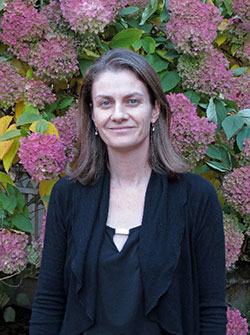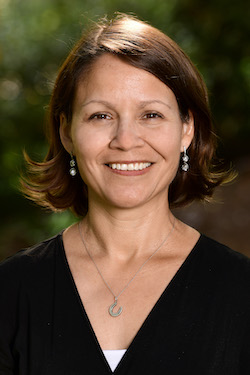Adverse Outcome Pathways: Session II - Assembling and Assessing AOP Information
Sponsored by: NIEHS Superfund Research Program
Archived: Wednesday, November 29, 2017
The NIEHS Superfund Research Program (SRP) is hosting a seminar series focused on adverse outcome pathways (AOPs), which are structured ways to represent biological events leading to adverse health effects. In the second session, presenters will discuss the development of AOPs and how they may be used to support hazard and risk assessment.
Carole Yauk, Ph.D., will briefly review common AOP development principles, including identifying key events, and assembling and weighing the evidence to support key event relationships and the overall AOP. A case study will then walk through development of one AOP using the AOP wiki. Using alkylation of DNA as the molecular initiating event, subsequent key events that are measurable and essential will be identified. Key event relationships will be identified and evaluated by assessing the dose, incidence and temporal relationships among the events. The essentiality of each event to the adverse outcome, heritable mutations, will be assessed and the empirical evidence supporting the AOP, and any uncertainties, will be evaluated.
Ed Perkins, Ph.D., will discuss efforts to merge the AOP's simple framework for linking effects to a regulated outcome with more biological pathways and measurements such as omics that try to capture the complexity of biology in order to support hazard and risk assessment. Examples will be given on how 'omics and other data can be used in the context of AOPs to assess chemical mixture impacts and how in vitro or in vivo data can be used to determine the likelihood of an AO occurring (e.g. Bayesian AOP networks and mechanistic qAOPs).
The AOP framework provides a logical mechanism based structure for formalizing and visualizing the molecular intersection between chemical and nonchemical stressors. However, the impact and relevance of biomedical research public health protection from chemical and nonchemical exposures depends both on the understanding of mechanisms embedded in the AOP framework, and how exposures themselves affect those mechanisms and the likelihood of adverse outcomes.
Justin Teeguarden, Ph.D., will introduce similar frameworks for organizing exposure information (like the aggregate exposure pathway (AEP)) and discuss how they can provide critical information about the magnitude of the stress and key information about how environmental concentrations can be related to human exposures. He will also discuss how exposures in studies conducted in vitro or an animal models can be related to human exposures.
This webinar is also in support of an upcoming NIEHS/NHLBI Workshop, Understanding the Combined Effects of Environmental Chemical and Non-Chemical Stressors: Atherosclerosis as a Model, which will take place at NIEHS in Research Triangle Park, North Carolina, April 3 - 4, 2018. The goal of this workshop is to identify key biological mechanisms and pathways of the combined effects of chemical and non-chemical stressors associated with atherosclerosis. This workshop will use the AOP framework to assist in the discussion of the pathways considered by workshop participants.
Accessibility, Recording, and Content Disclaimer
Rehabilitation Act Notice for Reasonable Accommodation
It is EPA's policy to make reasonable accommodation to persons with disabilities wishing to participate in the agency's programs and activities, pursuant to the Rehabilitation Act of 1973, 29 U.S.C. 791. Any request for accommodation should be made to Sara Amolegbe at 919-213-4906 or samolegbe@michaeldbaker.com, preferably one week or more in advance of the webinar, so that EPA will have sufficient time to process the request. EPA would welcome specific recommendations from requestors specifying the nature or type of accommodation needed. Please note that CLU-IN provides both alternate phone call-in options and closed captioning for all webinars, and requests for these specific accommodations are not necessary.
Webinar Recording
By participating in this CLU-IN webinar, you automatically agree to authorize recording of audio and visual content presented during this live event and consent to subsequent use of this recording in the public domain by the U.S. Environmental Protection Agency. This recording may include questions, comments and poll responses provided by you during the live event in addition to your name, voice, image or likeness. This recording will be made available after the conclusion of the live event as part of the CLU-IN webinar archives, and will remain available indefinitely. If you do not wish to consent to the recording, please do not join the live event, and contact Jean Balent at 202-566-0832 or balent.jean@epa.gov to discuss your concerns.
Content Disclaimer
This webinar is intended solely to provide information to the public. The views and opinions expressed as part of this webinar do not necessarily state or reflect those of the U.S. Environmental Protection Agency. It is not intended, nor can it be relied upon, to create any rights enforceable by any party in litigation with the United States, or to endorse the use of products or services provided by specific vendors. With respect to this webinar, neither the United States Government nor any of their employees, makes any warranty, express or implied, including the warranties of merchantability and fitness for a particular purpose, or assumes any legal liability or responsibility for the accuracy, completeness, or usefulness of any information, apparatus, product, or process disclosed, or represents that its use would not infringe privately owned rights.
Presenters:
 Carole L. Yauk, Ph.D., Genomics Laboratory, Environmental Health Sciences and Research Bureau, Health Canada (Carole.Yauk@canada.ca or 613-941-7376)
Carole L. Yauk, Ph.D., Genomics Laboratory, Environmental Health Sciences and Research Bureau, Health Canada (Carole.Yauk@canada.ca or 613-941-7376)
Carole L. Yauk, Ph.D. is the Lead of the Genomics Laboratory in the Environmental Health Science and Research Bureau at Health Canada, and an adjunct professor of Biology at Carleton University. Dr. Yauk is co-chair of Health Canada's Genomics Working Group, and co-chair of the Application of Genomics to Mechanism Based Risk Assessment Technical Committee of the Health and Environmental Sciences Institute. She is a Canadian delegate to the OECD's Extended Advisory Group on Molecular Screening and Toxicogenomics and an active participant in their Adverse Outcome Pathway program. Her current research is focused on the development and implementation of genomics approaches to improve and expedite risk assessment, and novel approaches to assess potential heritable effects of environmental exposures. She has published over 140 papers in these areas.
 Edward J. Perkins, Ph.D., U.S. Corps Engineers Army Engineer Research and Development Center (Edward.J.Perkins@erdc.dren.mil or 601-634-2872)
Edward J. Perkins, Ph.D., U.S. Corps Engineers Army Engineer Research and Development Center (Edward.J.Perkins@erdc.dren.mil or 601-634-2872)
Edward J. Perkins, Ph.D., currently serves as the Army Senior Research Scientist (ST) in Environmental Networks and Genetic Toxicology in Environmental Laboratory at the U.S. Corps Engineers Army Engineer Research and Development Center. Dr. Perkins received his PhD at Washington State University investigating the molecular biology of 2,4-D degradation by Alcaligenes eutrophus JMP4. Prior to joining ERDC, Dr. Perkins worked in development of transgenic plants for phytoremediation and molecular measures of soil quality. Dr. Perkins joined the ERDC Environmental Laboratory in 1996 where he established an internationally recognized genetics research laboratory to examine chemical impacts on a wide range of species including rat, bobwhite quail, Japanese quail, earthworms, fish (Fathead Minnow and Zebrafish), invertebrates (daphnia) and coral. His current work focuses on advancing methods in regulatory toxicology such as the AOP framework, understanding the impact of chemical mixtures on the environment, the development and application of new tools and approaches for alternative methods in toxicology, and exploring how biotechnology can improve our environment.
 Justin Teeguarden, Ph.D., Environmental and Biological Sciences Directorate, Pacific Northwest National Laboratory (jt@pnnl.gov)
Justin Teeguarden, Ph.D., Environmental and Biological Sciences Directorate, Pacific Northwest National Laboratory (jt@pnnl.gov)
Justin Teeguarden, Ph.D., is a Staff Scientist and Chief Exposure Scientist in the Environmental and Biological Sciences Directorate at the Pacific Northwest National Laboratory. He holds a Joint Faculty position with the Oregon State University Department of Environmental and Molecular Toxicology, where he serves as the Director of the OSU-PNNL-Superfund Center Research Translation Core. He also directs the Texas A&M Superfund Exposure Science Core. Dr. Teeguarden's research focuses on computational and experimental exposure assessment in humans, animals and cell culture systems. Over the last decade, his research teams have focused on utilization of emerging technologies, novel experimental data and computational methods for solving public health challenges related to human exposure to chemicals. He is currently the Director of the Pacific Northwest National Laboratory Exposure Surveillance and Health Optimization (ESHO) Consortium and the Chief Exposure Scientist, where he leads efforts to develop non-targeted analytical methods for characterizing the exposome. Dr. Teeguarden has received several awards from the Society of Toxicology for his work in computational and experimental exposure science as they relate to translating exposures across cell-culture, human, and animal test systems. Dr. Teeguarden has served as the president of the Dose-Response Specialty Section of the Society for Risk Analysis, and as President of the Nanotoxicology Specialty Section of the Society of Toxicology. He received his PhD in toxicology from the University of Wisconsin, Madison and is board certified in Toxicology.
Moderator:
 Danielle J. Carlin, Ph.D., D.A.B.T., NIEHS Superfund Research Program (danielle.carlin@nih.gov)
Danielle J. Carlin, Ph.D., D.A.B.T., NIEHS Superfund Research Program (danielle.carlin@nih.gov)
Danielle Carlin, Ph.D., D.A.B.T., is a health scientist administrator with the NIEHS Superfund Research Program (SRP). Her position consists of providing guidance and advice to grantees applying for SRP Center grants and serving as the lead liaison between SRP trainees and the various training opportunities offered by SRP. Her current research interests include chemical mixtures, combined exposures, metals, asbestos, and xenobiotic metabolism. Dr. Carlin conducted her postdoctoral training at the University of North Carolina, where she first studied aerosolized drugs/vaccines for treatment and prevention of tuberculosis for two years and then focused on the toxicological effects of exposure to Libby amphibole asbestos in the rat model. She received her Ph.D. in 2005 from Kansas State University, College of Veterinary Medicine, Department of Anatomy and Physiology. She also has a B.S. and M.S. in animal science from New Mexico State University.
Webinar Slides and References:
- Slide Presentation for Carole L. Yauk, Ph.D.,Genomics Laboratory, Environmental Health Sciences and Research Bureau, Health Canada:
- Slide Presentation for Edward J. Perkins, Ph.D., U.S. Corps Engineers Army Engineer Research and Development Center:
- Slide Presentation for Justin Teeguarden, Ph.D., Environmental and Biological Sciences Directorate, Pacific Northwest National Laboratory:
Webinar Slides and References:
- Slide Presentation for Carole L. Yauk, Ph.D.,Genomics Laboratory, Environmental Health Sciences and Research Bureau, Health Canada:
- Slide Presentation for Edward J. Perkins, Ph.D., U.S. Corps Engineers Army Engineer Research and Development Center:
- Slide Presentation for Justin Teeguarden, Ph.D., Environmental and Biological Sciences Directorate, Pacific Northwest National Laboratory:
Additional Resources:
- AOP wiki
- AOP Knowledgebase
- Effectopedia: The Online Encyclopedia of Adverse Outcome Pathways
- Users' Handbook Supplement to the Guidance Document for Developing and Assessing Adverse Outcome Pathways
- OECD Series on Adverse Outcome Pathways
- AOP: Alkylation of DNA in Male Pre-meiotic Germ Cells Leading to Heritable Mutations
If you have a suggested topic or idea for a future CLU-IN internet seminar, please contact:
Technology Integration and Information Branch
PH: 202-566-0832 | Email: balent.jean@epa.gov
Technology Integration and Information Branch
PH: 202-566-0875 | Email: adam.michael@epa.gov





